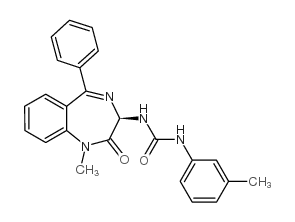L-365,260

L-365,260 structure
|
Common Name | L-365,260 | ||
|---|---|---|---|---|
| CAS Number | 118101-09-0 | Molecular Weight | 398.45700 | |
| Density | 1.23g/cm3 | Boiling Point | 611.5ºC at 760 mmHg | |
| Molecular Formula | C24H22N4O2 | Melting Point | N/A | |
| MSDS | Chinese USA | Flash Point | 323.6ºC | |
| Symbol |


GHS06, GHS09 |
Signal Word | Danger | |
Use of L-365,260L-365260 is a potent and selective antagonist of non-peptide gastrin and brain cholecystokinin receptor (CCK-B), with Kis of 1.9 nM and 2.0 nM, respectively. L-365260 interacts in a stereoselective and competitive manner with guinea pig stomach gastrin and brain CCK receptors. L-365260 can enhance Morphine analgesia and prevents Morphine tolerance[1][2][3]. |
| Name | N-[(3R)-2,3-dihydro-1-methyl-2-oxo-5-phenyl-1H-1,4-benzodiazepin-3-yl]-N′-(3-methylphenyl)-urea |
|---|---|
| Synonym | More Synonyms |
| Description | L-365260 is a potent and selective antagonist of non-peptide gastrin and brain cholecystokinin receptor (CCK-B), with Kis of 1.9 nM and 2.0 nM, respectively. L-365260 interacts in a stereoselective and competitive manner with guinea pig stomach gastrin and brain CCK receptors. L-365260 can enhance Morphine analgesia and prevents Morphine tolerance[1][2][3]. |
|---|---|
| Related Catalog | |
| Target |
Ki: 1.9 nM (gastrin); 2.0 nM (CCK-B)[1] |
| In Vitro | L-365260 (1 μM) strongly attenuates the CCK8S- and CCK4-mediated depolarization in a different neuron[2]. L-365260 exhibits a similar high affinity for brain CCK-B receptors of rats, mice and man, and a lower affinity for gastrin and brain CCK-B (IC50=20-40 nM) receptors in dog tissues[1]. |
| In Vivo | L-365260 (0.01-10 mg/kg; s.c.) enhances analgesia induced by a submaximal dose of Morphine (4 mg/kg) in rats[3]. L-365260 (0.2 mg/kg; s.c. twice daily for 5 days) significantly prolongs the duration of Morphine analgesia in rats[3]. L-365260 (0.1-30 mg/kg; p.o.) antagonizes gastrin-stimulated acid secretion in mice (ED50=0.03 mg/kg), rats (ED50=0.9 mg/kg) and guinea pigs (ED50=5.1 mg/kg)[1]. Animal Model: Male Sprague-Dawley rats (300-350 g) were injected with Morphine[3] Dosage: 0.01, 0.05, 0.1, 0.2, 0.75, 1.0, 10.0 mg/kg Administration: S.c. 10 min prior to i.p. injection of 4 mg/kg Morphine Result: Enhanced morphine analgesia. |
| References |
| Density | 1.23g/cm3 |
|---|---|
| Boiling Point | 611.5ºC at 760 mmHg |
| Molecular Formula | C24H22N4O2 |
| Molecular Weight | 398.45700 |
| Flash Point | 323.6ºC |
| Exact Mass | 398.17400 |
| PSA | 73.80000 |
| LogP | 3.92110 |
| Vapour Pressure | 6.85E-15mmHg at 25°C |
| Index of Refraction | 1.648 |
| InChIKey | KDFQABSFVYLGPM-QFIPXVFZSA-N |
| SMILES | Cc1cccc(NC(=O)NC2N=C(c3ccccc3)c3ccccc3N(C)C2=O)c1 |
| Storage condition | 2-8°C |
| Symbol |


GHS06, GHS09 |
|---|---|
| Signal Word | Danger |
| Hazard Statements | H301-H400 |
| Precautionary Statements | P273-P301 + P310 |
| RIDADR | UN2811 - class 6.1 - PG 3 - EHS - Toxic solids, organic, n.o.s., HI: all |
|
Combination pharmacotherapy for the treatment of neuropathic pain in adults.
Cochrane Database Syst. Rev. 7 , CD008943, (2012) Pharmacotherapy remains an important modality for the treatment of neuropathic pain. However, as monotherapy current drugs are associated with limited efficacy and dose-related side effects. Combining... |
|
|
Modeled structure of a G-protein-coupled receptor: the cholecystokinin-1 receptor.
J. Med. Chem. 48(1) , 180-91, (2005) The Cholecystokinin-1 receptor (CCK1R) mediates actions of CCK in areas of the central nervous system and of the gut. It is a potential target to treat a number of diseases. As for all G-protein-coupl... |
|
|
A cholecystokinin-1 receptor agonist (CCK-8) mediates increased permeability of brain barriers to leptin.
Br. J. Pharmacol. 154(5) , 1009-15, (2008) Leptin regulates energy expenditure and body weight by acting both on the hypothalamus and on peripheral targets. Central actions of leptin are enhanced by cholecystokinin (CCK). The interaction betwe... |
| L-365,260,N-[(3R)-2,3-Dihydro-1-methyl-2-oxo-5-phenyl-1H-1,4-benzodiazepin-3-yl]-N'-(3-methylphenyl)urea |
| L-365260 |